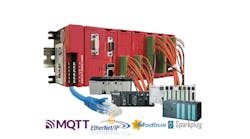For any of us grey beards, the introduction of yet another “universal” I/O system is sure to be met with rolling eyes and a big sigh. Like the proverbial better mouse trap, what could another way to connect automation devices have that would be better than all the other innovations? CANbus, DeviceNet, Profibus, ControlNet, Ethernet, AS-i—how do we sort through all the offerings and figure out what is best? How about all the media choices to connect these? Can’t we just have one protocol that can be used with all?
First introduced a few years ago in Europe, IO-Link seems to be gaining traction in the North American market of late. An extension of the globally recognized PLC standard, IEC 61131, IO-Link (IEC 61131-9) is an open standard protocol that is the first system designed with legacy in mind. We’ve been connecting to sensors and actuators with the familiar brown, blue and black wires for years. More recently we have taken to connecting these with an M12 connector to make them quick connect/replacement. What a brilliant concept it was to use those same three wires to carry other information along the line without compromising the true purpose of a sensor or actuator.
IO-Link enables the transmission of process and service data, as well as events, all in a familiar physical connection format.
- Process data shows the latest state of a device or communicates the desired state of an actuator. This critical data is updated every communication cycle.
- Service data allows the user to access detailed information about the particular sensor and device. This can be as limited as manufacture, model and serial number but can contain as much as 16,000 blocks worth of data per device. Some blocks are protocol-defined, while others can be custom to a particular manufacturer.
- Events that occur too rarely to include in the process data but should happen more frequently than a service-data request can be delivered using an event. This provides a means by which standard or vendor-specific data about alarms or information messages can be delivered as things happen.
Most users of automation have no idea that a large selection of the sensors and actuators that they use every day in their design/builds already have IO-Link capabilities built in. Such was the case for me when I recently enjoyed a visit with one of my local vendors. I’ve been using the particular brand of products since the early ’80s and was a little leery about the prospect of some young “fella” coming into my meeting room to tell me about a new way to connect my stuff. I immediately had flashbacks to some of the early nightmares of setting up a DeviceNet network and the trials and tribulations of early Profibus. What could this new technology offer me that I hadn’t already rejected so many years ago?
Now, to be fair, I have come to a détente, we shall say, about networking. There is a time and place for them, and, let’s face it, most of the bugs have been worked out to the point where it’s commonplace to just hook the field I/O up to a block of some sort and plug the homerun cable in. Like any newfangled thing, it takes a bit of time to sort it all out, and I think we are there.
The nice thing about IO-Link is we don’t have to jump in right away. For those of us who are reluctant to put our feet to the fire, we can start by just selecting the same good sensors and actuators that we already use. In many cases, your favorite photoeye or proximity switch already has IO-Link embedded. The great part about an IO-Link device is it will behave like the same old “dumb” device we always use, if it isn’t connected to an IO-Link master. The magic truly happens when that same device is connected to the I/O protocol device.
Once connected, we enter the world of advanced diagnostics, automatic device configuration, multiple profiles, statistical trending and descriptive tags, all embedded in the device. Data from each device can be used to evaluate the performance and improve uptime by implementing predictive measures and activities.
The significance of technology such as IO-Link is that the investment can be gradual. As a designer of control systems, we probably have a preferred way of doing things. From the moment of our first-ever design, we are looking to create systems that we are familiar with. We don’t want to have to do a detailed evaluation of components and features every time we start a new job. How would we make any profit? Profit comes from repeatability and using pre-canned solutions as part of our designs.
The parade of products and solutions before IO-Link relied on a configured system from start to finish. Master and slave modules, mapping the memory exchange from the master to the PLC, specific physical media from panel to field and specialized sensors and actuators that communicated with the desired protocol—all for a significant increase in price to deploy. Remember all the different connection methods? Every new I/O system had its own connectors and shells. How about if you made a machine with DeviceNet components and your next client wanted the same machine but with Profibus? Head drops, a big sigh and you start all over. Learning the protocol, choosing the media, going through the trials and tribulations of figuring it out all over again.
At present there are 127 member companies in the IO-Link Consortium (www.io-link.com). Nearly every major automation company is represented. It is a virtual who’s who of connectivity. For perhaps the first time, the industry has lined up behind a single protocol. To a controls designer, this is a key development. No longer will you have one hand tied behind your back because you are loyal to a particular PLC brand. You will no longer have to stick with a particular sensor manufacturer because it favors AS-i or DeviceNet or Profibus. The IO-Link Consortium isn’t heavy on European or Asian or North American hardware manufacturers. It is truly a united federation of automation suppliers.
So, where do you start? Start by reaching out to your vendors of choice. Ask them what they have in their stable that is IO-Link compatible. You will be surprised by the answer, much as I was. My photoeye guy? He’s there. My proximity switch of choice? Yep, there, too. My favorite cable and connector suppliers? Yes, they are all there. Guess what? My favorite actuators, both of them, are represented in the consortium. Many of these products have had IO-Link embedded for some time, so there is no change in the cost of deployment. These are the same sensors and actuators you have in your stock room right now. Once you have compiled your list of field devices that can use IO-Link, delve into the architecture to make use of the features. Remember that the connection to the field device is still that same three-wire cordset that you know and love.
ALSO READ: Electrical Noise Forces the Choice
Jumping into the world of IO-Link isn’t just about climbing on the latest bandwagon. Adopting a standard helps to streamline your concept-to-product journey. Any foray into quick-connect technology also brings you to the next level of manufacturing, and, when that quick-connect technology includes a potential stream of data to and from a device, you have automatically made your product smarter. Use as little or as much of that data as you like. You could start by just replacing your current I/O array with IO-Link. Simple digital devices sending 1s and 0s back to the PLC. The PLC sending 1s and 0s out to your actuators. Then, when you feel good about those transactions, add some smarts. Tap into the smarts of your sensor to determine not just if it is turning off and on, but how well it is doing it. Is your photoeye positioned to give you the best on-off signal? Are you close to the sensor edge? Is your actuator responding appropriately to the command you send it? What is that device? Who makes it? What is the part number? Imagine how convenient it would be for the maintenance person to have that information supplied on the operator screen. Imagine your system telling the maintenance person that the part that was just installed doesn’t match the part that it is intended to replace. The possibilities are endless.
Most of the mainline PLC platforms have software tools embedded in their products to take advantage of the IO-Link protocol. Gone are the days of figuring out the input, output and configuration data blocks and mapping the bits and bytes out into meaningful information. When a manufacturer enters into a common marketplace where everyone has access to the same technology and the same connectivity, that manufacturer is compelled to spend time and resources to make the product stand out from the competition. This is a win-win situation for manufacturer and controls designers alike. If a manufacturer wants you to buy its component and the component has the same basic functions, connection and protocol in common, the manufacturer is going to make the product easier to use than its competitors’. The designer benefits from the healthy competition between the various manufacturers.
Rick Rice is a controls engineer at Crest Foods, a dry-foods manufacturing and packaging company in Ashton, Illinois. With nearly 30 years’ experience in the field of automation, Rice has designed and programmed everything from automotive assembly, robots, palletizing and depalletizing equipment, conveyors and forming machines for the plastics industry but most of his career has focused on OEM in the packaging machinery industry with a focus on R&D for custom applications. Contact him at [email protected].






